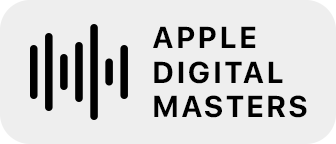Editorial Note

Mastered for iTunes is now Apple Digital Masters. On 08/07/2019 Apple Music announced the launch of Apple Digital Masters, a rebranding initiative that combines all of Apple’s Mastered for iTunes collections into one catalog. The iTunes® brand is finished, but the technical standard, and its justification, remain the same.
Apple notes that the majority of top releases on Apple Music as of 2019 are Apple Digital Masters, specifically about 75% of of the Top 100 in the U.S. and 71% of the Top 100 globally. The details in this 2013 article remain as valid as ever. Enjoy.
Why Mastered for iTunes Matters
by Rob Schlette
This article explains the Mastered for iTunes program, and why it’s an important benchmark for digital music distribution.
Masters v Premasters

Like nearly every other digital music distribution channel, iTunes doesn’t really want a master; they want a premaster. The so-called ‘mastering’ process is actually two related, but operationally discrete sub-processes:
- Premastering, which encompasses all of the aesthetic decisions related to preparing a set of mixes for an audience. Premastering answers any questions related to what the record is going to sound like.
- Mastering, which is the process of creating the delivery media that will allow the audience to access the material. In the case of iTunes, this includes encoding an Apple AAC file and adding the appropriate metadata.
It doesn’t matter if you’re a major label dealing directly with iTunes or a self-released artist using an aggregator; iTunes wants a specific digital audio premaster so that they can do the encoding (i.e. mastering) in-house.
So what do they want, and how do you know that your master is going to turn out the way you want it to? That’s precisely what the Mastered for iTunes program is all about.
Codecs and Compensated Premasters
The goal of any digital audio codec is to take a high-resolution or CD-quality digital audio file, and generate an encoded file that retains as much of the subjective audio quality as possible, but with a reduced file size. Regardless of anyone’s opinion of any particular codec, if your music is going to be sold on iTunes, it’s going to be encoded by Apple using their variable bit rate 256kbps AAC encoding format.
This introduces an important issue. Apple AAC is not lossless. This means the sound of the master may be discernably different than the premaster.
The key to managing this off-site encoding issue is to reference mixes and premasters through a round-trip codec plugin that provides real-time auditioning of the Apple AAC process. Apple has provided the AURoundTripAAC Audio Unit for that very purpose. In addition, the Sonnox Fraunhofer Pro-Codec provides the same facility. The purpose of these tools is not to create encoded masters, but to audition them using the very same technology that will be used when they are encoded off-site.
If your workstation lacks the technical specs to run these real-time tools, Apple has also provided the afconvert utility. This command-line tool facilitates off-line encoding using the same codec technology as the tools described above.
Best Practices and Deliverables
The Apple AAC codec performs measurably better with high-resolution digital audio input than with CD-quality input. A cursory review of the technology behind variable bit rate encoding should confirm this. ABX listening tests can do the same.
Apple’s Best Practices for Mastering for iTunes lays out the recommended WAV file deliverables:
- “An ideal master will have 24-bit, 96kHz resolution.”
- “Don’t upsample files to a higher resolution than their original format.”
To reiterate, a CD premaster is an inferior input to the iTunes delivery system. 24-bit WAV files with sample rates from 44.1kHz-192kHz are recommended.
Additionally, Apple recommends that these digital audio files include “a small amount of headroom (roughly 1dBFS).”
When D/A converters generate a continuous waveform using digital audio data, there are analog levels greater than the maximum peak sample level. When oversampling is used during playback, this issue can be compounded. It is common practice to leave some amount of headroom to avoid inter-sample clipping, even for un-encoded masters.
Many mixers and mastering engineers employ reconstruction metering to manage inter-sample audio levels. Apple has also provided afclip, which is a command-line tool for checking both sample and 4x oversampled peaks. afclip provides both quantitative and GUI outputs for locating clips.
Bottom line: Apple is requesting 24-bit WAV premasters with native sample rates and approximately 1dB of peak headroom.
Why Mastered for iTunes Matters
CD-DA is not the primary music delivery medium anymore. The 2016 RIAA Music Industry Shipment Stats showed that, “digitally distributed formats comprised 75.5% of the total US market by dollar value in 2016.” What is the sense in continuing (intentionally or not) to master strictly for CD? Ignoring a concerted, thoughtful approach to delivering music for digital distribution ignores the statistical bulk of the listening audience.
The Mastered for iTunes Best Practices aren’t the least bit obscure or esoteric. In fact, they’re a good de facto standard for any digital premaster delivery. The loudest argument for ignoring the Mastered for iTunes program is that streaming music sources have overtaken digital download outlets as the primary source of music (digital or otherwise). That observation seems to make a better case for coordinated premaster deliver standards than against.
The basic premise behind Mastered for iTunes is that AAC is not CD-DA, so best-quality results require unique deliverables. This has been true (and well-accepted) for vinyl, cassette, broadcast radio, etc. The technology required for listenable streaming music certainly requires a similar (if not more complex) consideration.
Mastered for iTunes is a simple standard for providing predictable high-quality results for one of music’s most popular retail distribution channels. Beyond that, it is an excellent chance for the pro audio community to get in the good habit of carefully considering and accommodating digital music distribution.
